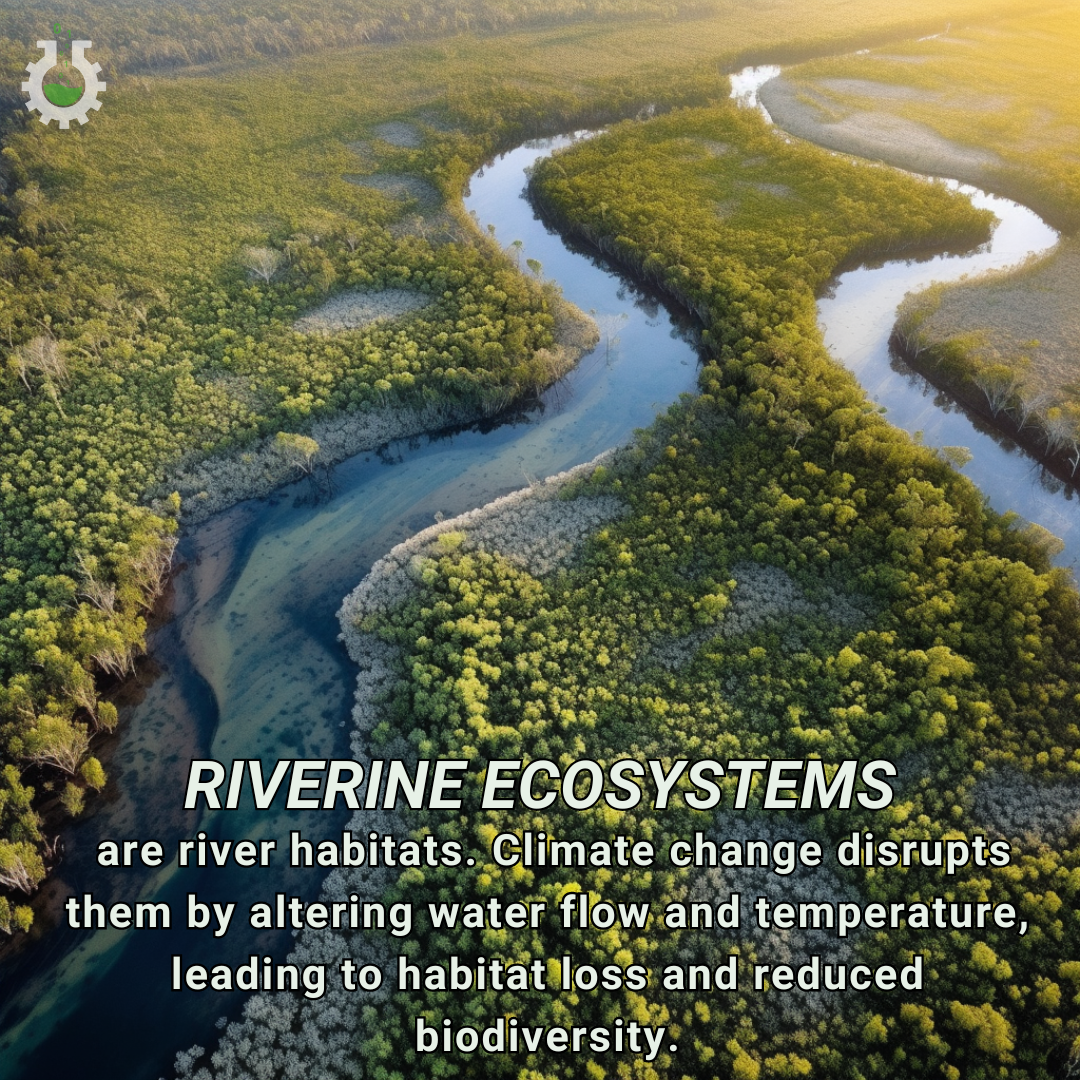July 10, 2024
Climate Change Poster Collection of the Day – Riverine Ecosystems
Book a Demo
Today’s Climate Change Poster Collection highlights Riverine ecosystems, comprising the intricate networks of rivers, streams, and their surrounding environments, are among the most dynamic and vital components of our natural world. These ecosystems serve as lifelines that sustain a myriad of species, from microscopic plankton to large mammals, and support human communities by providing essential resources such as water for drinking, agriculture, and industry. However, these ecosystems are increasingly vulnerable to the multifaceted impacts of climate change, which threaten to disrupt their delicate balance and the myriad services they provide.
Rising global temperatures and altered precipitation patterns are among the most significant climate change-induced stressors affecting riverine ecosystems. These changes are leading to more frequent and severe droughts, floods, and storms, which in turn disrupt the natural hydrological cycles that many aquatic and riparian species rely on for breeding, feeding, and migration. For instance, altered flow regimes can affect the timing and intensity of seasonal floods, which are crucial for the reproduction of many fish species and the dispersal of seeds for riparian vegetation. Inconsistent water levels can also hinder the life cycles of amphibians and insects, which are essential components of the riverine food web.
Warmer water temperatures pose another critical threat to riverine ecosystems. As temperatures rise, the solubility of oxygen in water decreases, leading to lower dissolved oxygen levels that can stress or even kill aquatic organisms. Fish, in particular, are highly sensitive to changes in temperature and oxygen levels. Species such as salmon and trout, which require cold, oxygen-rich waters, are especially vulnerable. Additionally, warmer temperatures can promote the growth of harmful algal blooms, which produce toxins that can devastate water quality and aquatic life. These blooms can also create dead zones—areas of water with such low oxygen levels that most marine life cannot survive.
Climate change also exacerbates the spread of invasive species, which can outcompete native flora and fauna, leading to a loss of biodiversity. Invasive species often thrive in disturbed environments and can quickly dominate ecosystems that are already stressed by climate change. For example, the introduction of non-native plants can alter the structure and function of riparian zones, affecting everything from soil stability to nutrient cycling. Invasive aquatic species, such as certain types of fish and mollusks, can disrupt food webs and outcompete native species for resources.
Human activities, such as dam construction and water extraction, compound these issues by fragmenting habitats and reducing the resilience of riverine ecosystems to climate-related stresses. Dams, while providing benefits such as hydroelectric power and water storage, can significantly alter the natural flow of rivers, disrupting the migration patterns of fish and other aquatic organisms. Water extraction for agriculture and industry can reduce river flows to critical levels, exacerbating the impacts of drought and increasing the concentration of pollutants.
The health of riverine ecosystems is also closely tied to the well-being of human populations. These ecosystems provide essential services such as drinking water, irrigation, and fisheries, which are crucial for the livelihoods of millions of people. As climate change intensifies, the socio-economic impacts on communities that depend on these ecosystems become more pronounced. Reduced water availability and quality can lead to conflicts over water resources, affect food security, and increase the vulnerability of communities to natural disasters.
Protecting and restoring riverine ecosystems in the face of climate change requires a holistic approach that considers both ecological and human dimensions. Adaptive management practices, such as the restoration of natural flow regimes and the implementation of sustainable water use practices, are essential for enhancing the resilience of these ecosystems. Efforts to restore riparian vegetation, remove invasive species, and improve water quality can also help to mitigate the impacts of climate change.
Moreover, integrated management strategies that involve stakeholders from multiple sectors, including government, industry, and local communities, are crucial for ensuring the sustainable use and conservation of riverine ecosystems. By understanding and addressing the complex interactions between climate change and riverine ecosystems, we can work towards safeguarding these vital natural resources for future generations. This requires a concerted effort to reduce greenhouse gas emissions, promote sustainable land and water use practices, and invest in research and monitoring to better understand the impacts of climate change on these ecosystems.
Riverine ecosystems are intricately connected to the broader climate system and are highly sensitive to changes in temperature, precipitation, and human activities. The impacts of climate change on these ecosystems are profound and multifaceted, affecting everything from water quality and biodiversity to the livelihoods of human communities. By adopting a holistic and integrated approach to management and conservation, we can enhance the resilience of riverine ecosystems and ensure their continued ability to provide essential services in a changing climate.
Discover an inspiring collection of climate change poster.



